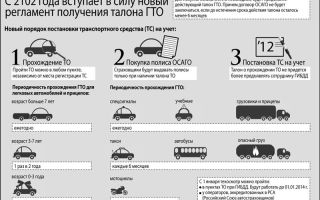Vehicle inspection times, choice of inspection point, cost
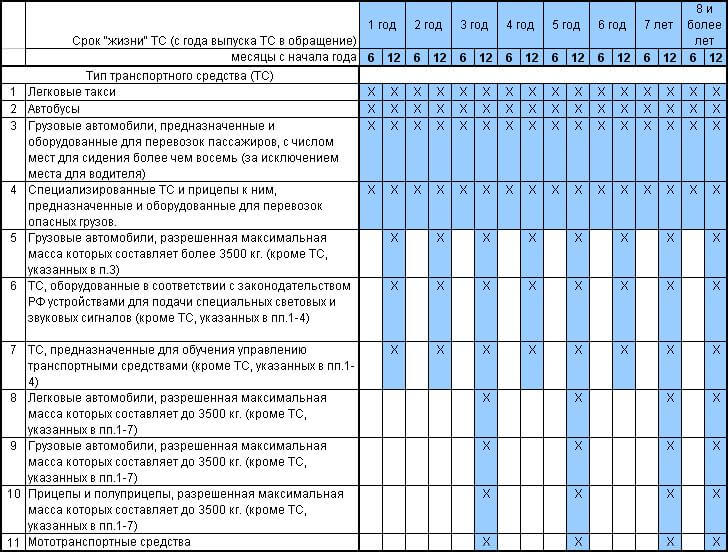

The main task of the technical inspection (TO) procedure is to detect any types of vehicle (V) malfunctions.
First of all, we are talking about road safety, the main components of which are not only the skill of the driver and the condition of the road surface, but also the serviceability of the vehicle.
Also, timely completion of maintenance is the main requirement for drawing up an MTPL agreement.
Diagnostic card
Since mid-2014, changes have been made to the current legislation, according to which the technical inspection coupon has been replaced by a diagnostic card (DC).
Now every car owner, when undergoing a maintenance procedure, receives a diagnostic card - a document confirming the proper condition of the vehicle.
The form and procedure for filling out the DC are regulated by law.
Document format is A4, all diagnostic results are entered in tabular form.
The most important information stored in this document is the conclusion that the vehicle meets safety requirements and is permitted for operation.
The document must be filled out both in handwritten form (2 copies) and in electronic form.
The document is certified by the signature of an expert from the company or operator, who has all the powers and qualifications to carry out maintenance.
Upon completion of vehicle diagnostics, one written copy of the card is given to the car owner, and the second is stored in the company’s archives for at least 3 years.
As for the electronic copy, it falls into the general EAISTO system (unified automated information system for technical inspection). The document is kept in the electronic database for at least 5 years.
There are situations in which the owner of a vehicle is forced to undergo an unscheduled technical inspection, that is, when the validity period of the vehicle license has not yet expired. For example, when traveling to a country where there are different rules for inspecting the technical condition of vehicles.
Trouble-shooting
It is quite possible that diagnostics will reveal malfunctions in the operation of mechanisms or damage hidden from the owner.
In order to receive a DC in such a situation, you will have to correct all the shortcomings within a specified period of 20 days , after which you will have to return to the expert conducting the maintenance and undergo an inspection again.
We emphasize that if the deadline allotted for troubleshooting is met, only corrected mechanisms and sections of the vehicle will be inspected. In this case, only newly rendered services in the appropriate amount are paid.
When applying for re-diagnosis to another maintenance operator, services and payment are made again and in full.
Maintenance deadlines
- Almost all new vehicles during the first 3 years from the date of production are exempt from the need for technical condition diagnostics.
- Vehicles aged from 3 to 7 years are subject to inspection every 2 years.
- Vehicles require annual examination if more than 7 years have passed since the date of issue.
In addition, since 2012, trailers weighing up to 3.5 tons that are the property of individuals are not subject to maintenance.
It often happens that a car purchased at a car dealership this year was produced at the factory at the end of the year before last. Accordingly, the owner of this car will have to undergo a technical inspection within a year.
When determining the date of the upcoming technical inspection, remember to take into account the year of manufacture of the vehicle indicated in the PTS.
Detailed information about maintenance periods for all vehicles is presented in the table:
Technical inspection operators
With the abolition of this type of document, such as a technical inspection coupon, the payment of state duty for its issuance was also abolished.
The process of undergoing maintenance has been significantly simplified due to the absence of the need to contact the traffic police. Car diagnostics now take much less time.
From now on, maintenance can be carried out by private organizations and individual entrepreneurs who have the appropriate accreditation certificate. This helps reduce queues and also allows you to choose the most convenient time for the car owner to undergo this procedure.
The service point is chosen by the car owner at will and is not tied to the place of registration of the vehicle.
You can find reliable information about operators accredited for this type of activity on the website of the Russian Union of Motor Insurers.
Price
Regarding the cost of the maintenance procedure, it is quite difficult to give a clear answer; the only characteristic of the price is regionality.
Maintenance operators independently set prices for the services provided, but they should not exceed the maximum permissible tariff determined by the legislation of the region.
It is worth noting that if the owner loses his copy of the DC, he will be able to obtain a copy from any TO operator on the day of submitting the corresponding application. A duplicate is issued based on the data contained in the EAISTO database. The cost of the service will be 1/10 of the maximum fee for maintenance established by the subject of the Russian Federation in which the point of circulation is located.
You can find out the relevance of the requested prices of operators for carrying out maintenance by reading the resolution of the subject of your residence “On the maximum fees for carrying out technical inspection of vehicles.”
conclusions
- Vehicles are subject to maintenance at intervals determined in accordance with the category and date of manufacture.
- A prerequisite for issuing an MTPL policy is to provide the insurer with a valid vehicle diagnostic card, regardless of its expiration date.
- For the provision of technical inspection services, you must contact only accredited maintenance operators.
- If you get into an accident, having a valid diagnostic card will help remove doubts about the causes of the accident. If the fact of a malfunction of the vehicle of a participant in an accident is established, the operator who issued a fictitious conclusion on the technical condition of the vehicle will bear responsibility.
If you have any questions, please contact our experts for clarification.
Get free legal advice now
Source: http://avtouristsovet.ru/avtovladenie/texosmotr/sroki-proxozhdeniya.html
Documents, terms and frequency of technical inspection of various types of cars in 2015
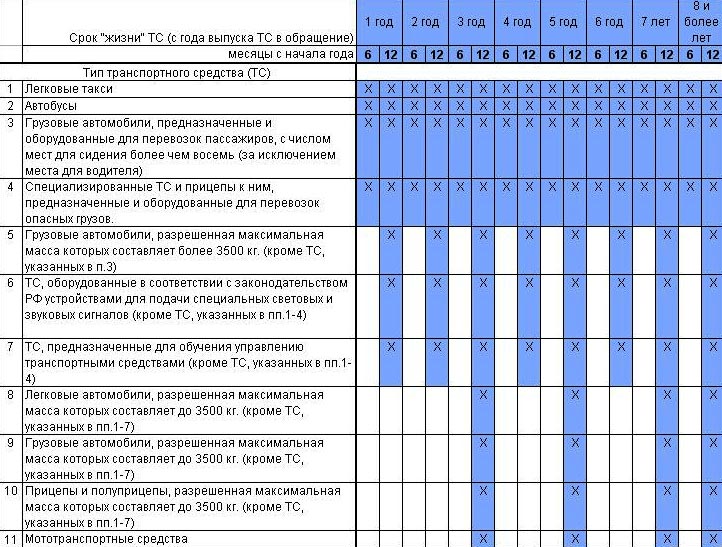
In order to move freely in your own car, without being afraid of every check, you need to undergo mandatory procedures on time - technical inspection and liability insurance. They require much less time, nerves and finances than paying late fees.
Documents for technical inspection in 2015
To pass the technical inspection, you only need two documents confirming the identity of the owner and the parameters of the vehicle.
- Passport.
- Car registration certificate or PTS (vehicle passport).
If it was not the owner, but his representative, who brought the car for inspection, they will require a document giving him the right to carry out the procedure on behalf of the owner (power of attorney).
Passage times for various types of transport
The frequency and validity of the technical inspection depends on the category of the car and its age.
- Passenger cars and trucks up to 3.5 tons, after 3 years from the year of production - technical inspection every 2 years.
- Passenger cars and trucks up to 3.5 tons, after 7 years from the year of production - annual technical inspection.
- Trucks over 3.5 tons, special equipment (vehicles with sound and visual signals, training) - annual technical inspection without reference to the year of production.
- Trucks with the ability to transport people (more than 8 seats without a driver), buses, passenger taxis, equipment for transporting dangerous goods (including trailers) - technical inspection every six months without reference to the year of production.
The law also provides for a time period within which the expert must complete the inspection.
- Cars and trucks up to 3.5 tons – from 30 to 43 minutes (depending on the type of fuel).
- Trucks up to 5 tons and passenger taxis – 54 minutes.
- Trucks up to 12 tons – 1 hour 3 minutes.
- Heavy loads heavier than 12 tons – 1 hour 7 minutes.
- Trailers heavier than 3.5 tons – 44 minutes.
In fact, this time depends on the professionalism of the inspector, the level of technical equipment of the operator and the condition of the vehicle.
New car
To reduce the load on inspection points and make life easier for car owners, the law provides for the exemption of new cars from undergoing technical inspection. It applies to two types of machines.
- Passenger cars up to 3 years from the year of production.
- Trucks up to 3.5 tons, up to 3 years from the year of production.
Having bought a car from scratch, you can safely drive it for 3 years without a technical inspection, only with insurance. If the car was purchased before the end of July 2012, the issued coupon is valid until August 1, 2015. After the next check, they will issue a diagnostic card, all the data from which will be entered into a single database.
Cars
The inspection procedure includes checking the appearance of the car and diagnosing the main elements.
- Brake system (front, rear, parking).
- Engine.
- Exhausts (for toxicity).
- Liquids (for the level and tightness of containers).
- Steering system.
- Windshield washers and wipers.
- Wheels and tires (pressure, balancing, tread height).
- Doors (serviceability of locks and windows).
- Lighting system (serviceability and intensity).
- Mirrors.
- Glass (tinting permeability, cracks in the driver's side).
- Seats, seat belts, horn (strength and sound of signal).
They also check the presence of a first aid kit, fire extinguisher and emergency lights of a given type. Of course, the car should be thoroughly washed, not just the signs.
To avoid repeated technical inspection, you should inspect the car in advance at a service center or yourself.
If the expert still finds faults or deviations from the norm, they will give 20 days for repairs, after which they will again check the problematic parts or the entire machine (if contacting another organization).
Freight
Inspection of cars and trucks is carried out according to standard requirements, but the technical inspection of trucks has its own nuances.
- Check the wheel chocks.
- Check the body and trailer mounting and control systems.
- On trucks heavier than 7.5 tons, the mud guards on the wheels are checked (compliance with the tire dimensions).
- Check the presence of standard fire extinguishers (1 in the cabin and 1 in the body).
- Check the tightness of the auxiliary hydraulics (on trailers and lifted bodies).
There are no particular problems with the technical inspection of trucks, but not all operators are equipped with the means to diagnose them, so difficulties may arise when searching for an organization.
Rare
There are no legal age limits for cars. Even if the rarity is already in its second century, it will be accepted for technical inspection and, if there are no complaints, a diagnostic card will be issued.
A feature of vintage cars is their reduced equipment; when they were produced, many modern elements had not yet been invented.
When passing a technical inspection, this is not considered a violation, since the law only requires checking factory components.
Vehicles registered in another state
In order for us to freely use a car registered in another country, its technical compliance must be documented.
- “Green Card” is an international insurance policy, common in almost all border countries.
- MSTO – international technical inspection certificate. A standard document proving that the car has passed maintenance (accepted by most foreign countries back in the nineties of the last century).
If the car owner is not interested in purchasing such papers, he will have to undergo a technical inspection in Russia and purchase an MTPL policy.
1 Comment
Source: http://lifenofear.com/avtostrahovanie/tehosmotr/dokumenty-i-sroki.html
The nuances of passing and the cost of vehicle inspection
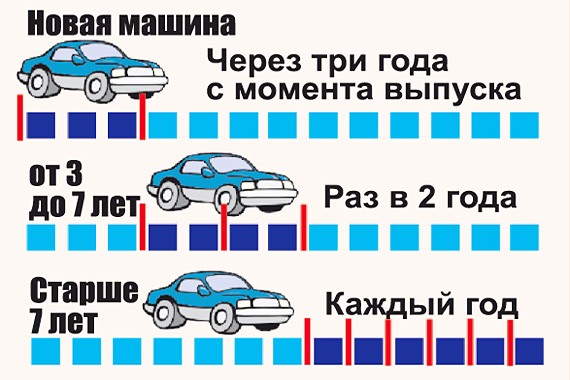
Every car owner knows how important it is to monitor the technical condition of their car. But this issue has also been consolidated at the legislative level.
Previously, technical inspection was carried out by traffic police officers at special inspection points and they issued a special coupon, without which the vehicle was not allowed to be used. Currently, the functions of monitoring the passage of maintenance have been transferred to insurers, and the inspection itself is carried out at private points.
Nevertheless, the seriousness of the procedure has not decreased at all, so every car owner should know all the features associated with undergoing maintenance, obtaining a diagnostic card, etc.
Why do you need a car inspection?
As before, the main purpose of conducting a technical inspection of vehicles is to ensure the safety of their use. During the inspection, specialists check the functionality of all units and components on which the possibility of normal operation of the vehicle depends, and eliminate the possibility of an emergency situation.
In fact, a technical inspection is a kind of permission for a car to participate in road traffic, since previously, after passing it, a coupon was issued (the vehicle was not allowed to be used without it).
Now there are no such coupons, but there is a diagnostic card, the absence of which makes it impossible to issue a motor vehicle liability insurance policy, and the absence of a policy is also a violation of traffic regulations.
Thus, carrying out maintenance is both a guarantee that the car is technically sound and a necessary part of the compulsory motor liability insurance registration process.
What is checked during a technical inspection?
Despite the fact that today technical inspection is carried out by many private operators, the procedure for passing is the same for all. Experts check the following:
- License plates for compliance with GOST and submitted documents;
- Availability of a first aid kit and fire extinguisher and their suitability;
- The presence of uncoordinated changes in the design of the vehicle;
- Brake system;
- Lighting equipment;
- Steering play;
- Degree of toxicity of exhaust gases;
- Serviceability of locks;
- Tread wear;
- Integrity of the windshield and rear-view mirrors;
- Level of technical fluids.
The inspection is carried out both by visual inspection and by using diagnostic equipment to check various components.
Procedure for passing technical inspection
To undergo vehicle maintenance, you must come to the selected inspection point, provide the specialists with a number of documents and, in fact, the car itself. The point’s employees will enter the data into a single database, where all the inspection results will be reflected. The car owner may be present during maintenance, but he has no right to interfere with the expert’s work.
If no comments are identified, then upon completion of the maintenance, a diagnostic card with permission to operate is issued. If any malfunctions are discovered that need to be eliminated, the card will be issued with a note that it is impossible to use.
The owner of the car must eliminate the identified deficiencies within twenty days and come for a second inspection. Here it is necessary to take into account that if a re-inspection is carried out at the same point as the first, only those components and systems that led to the refusal of permission to operate will be inspected.
If the car owner wants to undergo inspection at another point, then a full range of checks will be carried out there.
How to pass a technical inspection?
The success of passing MOT largely depends on how the car owner treats his vehicle. If the car is under constant supervision, its owner immediately eliminates any malfunctions that arise, then there will be no problems with passing a technical inspection. Experts give the following recommendations that will allow you to pass the inspection the first time:
- The car must be clean, all numbers readable;
- The first aid kit and fire extinguisher must not be damaged or expired, and their quantity must correspond to the type of vehicle;
- The windshield must not have cracks or chips in the area where the wipers operate, and the level of tinting of all windows cannot exceed the requirements of GOST;
- Additional equipment not specified in the title and vehicle registration certificate must be removed;
- Headlights must be in good working order and adjusted;
- The level of steering play should not exceed the requirements of GOST;
- The brake system must be fully operational, including the parking brake;
- Before carrying out maintenance, it is necessary to replace all technical fluids, and also inspect the car for leaks;
- All seat belts required by the vehicle design must be installed;
- It is necessary to refuel before maintenance at proven gas stations, since low-quality fuel can give poor toxicity levels in the exhaust gases;
- Car tires for maintenance must be new or have a short service life.
It is obvious that many car owners implement most of the advice on a daily basis, and not just before the need to undergo a technical inspection. But nevertheless, it is worth taking them into account, since this procedure is paid, and a repeated visit to the maintenance station entails additional expenses.
Where can I get a car inspection?
Currently, car owners have a wide choice of places to undergo maintenance. Firstly, it remains possible to pass it at specialized traffic police stations. In this case, a state technical inspection is carried out. Secondly, you can undergo maintenance at accredited points of private companies, including open ones, and at many dealership centers.
There are no differences in the inspection procedure, the list of examinations and checks between public and private points, and the right of choice always remains with the car owner, and you can undergo MOT regardless of the place of registration of the car or its owner. Here it is necessary to take into account that some maintenance points do not work with trucks due to the lack of appropriate premises. At the same time, state inspection centers can accept any vehicle for inspection.
What documents are needed for technical inspection?
To undergo a technical inspection, you must present a minimum list of documents:
- Certificate of registration of the vehicle or PTS;
- Owner's passport;
- Payment receipt;
- Power of attorney - if it is not the owner who presents the car for inspection, the document must indicate the authority to undergo a technical inspection.
No other documents are required, including no need to present a recent medical certificate of admission to drive a vehicle.
How much does a technical inspection cost?
Since the technical inspection has been largely transferred to private companies, the cost of passing now varies greatly depending not only from region to region, but also from point to point.
To be fair, it can be noted that in most regions, companies conducting maintenance have developed a uniform pricing policy, so the cost, if it differs, is insignificant. This uniformity of the cost of technical inspection was also influenced by government regulation, since the maximum cost of maintenance is determined by the authorities of the subject of the federation.
The national average price for maintenance today for a passenger car is 600-700 rubles (with a maximum price of 800 rubles). Inspections for trucks, buses, and heavy-duty trailers will cost more.
There is currently no requirement to pay a state fee for undergoing a technical inspection, even if the inspection is carried out at a traffic police station.
If you undergo a re-inspection, after eliminating the identified faults, the cost of maintenance cannot be higher than the initial one, but in most points for such an inspection they charge half the full cost, and traffic police points carry out a re-inspection free of charge, but only within twenty days from the date of the first inspection.
Frequency of vehicle inspection
It is necessary to undergo a technical inspection within strictly regulated periods, which depend on the age of the car and the specifics of its use.
Moreover, the last factor in determining the frequency of maintenance is more important than the age of the vehicle.
For example, for cars used for commercial passenger transportation, maintenance is required every six months, and this period is established even for new cars.
Inspection deadlines for new cars
Owners of new cars are not required to undergo a technical inspection for the first three years - this is the period defined by the legislator as the period when the car is working properly and there cannot be any defects in it that affect road safety.
Inspection deadlines for used cars
Three years after leaving the assembly line, the car must undergo maintenance, which will be valid for the next two calendar years. For a five-year-old car, there is also a two-year technical inspection period. The end of this period, that is, the car reaches seven years of age, means that the technical inspection becomes an annual procedure.
Fine for lack of technical inspection
Currently, there is no provision for liability for the lack of a valid technical inspection, since it is stipulated that without maintenance, the car owner cannot issue an MTPL policy.
However, this rule does not apply to vehicles for passenger transportation, equipped with special signaling devices used for training driving, as well as trucks weighing more than 3.5 tons.
They still remain liable for failure to undergo maintenance in the form of an administrative fine in the amount of 500 to 800 rubles.
What is a vehicle diagnostic card?
Modern vehicle inspection is closely related to a document such as a diagnostic card. It replaced the previously familiar inspection tickets, but has become more informative, and the procedure for issuing it has changed.
A diagnostic card, or instrumental control card, contains all the information on inspecting the car, as well as a conclusion about the possibility of operating the car. The card is signed by the expert conducting the inspection.
The card itself is filled out electronically, after which the electronic version enters a single database - EAISTO, where it is stored for five years. Two copies of the card are printed from the database: one is given to the car owner, the second will be stored at the inspection point for three years.
What does a diagnostic chart look like?
The diagnostic card is a unified A4 format form with certain sections on both sides of the sheet. The front side contains information:
- Unique card number;
- Information about the maintenance point;
- Card expiry date;
- Vehicle information;
- Diagnostic sheet.
On the reverse side:
- Continuation of the diagnostic sheet;
- Expert opinion on permission to operate;
- Space for the expert's signature and item seal;
- QR code with maintenance data.
These forms may differ in color and size of fields, but the content must be the same at all points.
Source: http://passus.ru/avto/tehosmotr-avtomobilya.html
How often do you need to undergo a technical inspection?
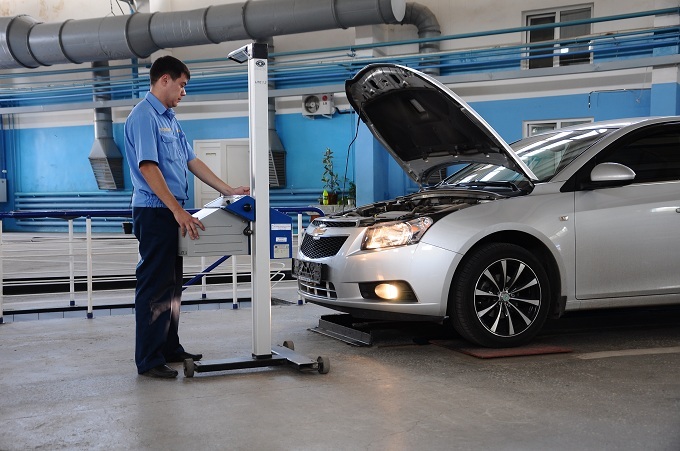
How often do you need to check the technical condition of a vehicle? In recent years, changes have been made to the law regulating the frequency of technical inspections, which have made life much easier for some car owners. We will try to tell you in detail about all the changes. Let's start with cars.
Cars
New passenger cars, up to three years from the date of production of the car (and not from the date of sale and start of operation), are completely exempt from undergoing maintenance.
That is, if the car was produced in 2013, but was sold only in 2015, then the inspection must be completed in 2016. Diagnostic cards are not issued for such vehicles.
Congratulations to all new car owners! Finally, there was one less absurd formality.
Passenger cars aged 3 to 7 years are required to undergo a technical inspection every 2 years.
Passenger cars over 7 years old must undergo maintenance annually.
Below we give the timing of technical inspection for other categories of vehicles.
Other categories of vehicles
Trucks
With a maximum weight of less than 3.5 tons:
- Children under 3 years of age are exempt from undergoing maintenance.
- Ages from 3 to 7 years - it is necessary to visit a technical inspection point once every 2 years.
- Those over 7 years of age are required to undergo technical inspection annually.
With a maximum weight of more than 3.5 tons (as well as trailers with a maximum weight of more than 3.5 tons) must undergo annual maintenance.
Motorcycles and ATVs
The need for a motorcycle inspection also depends on age:
- Up to 3 years - exempt from undergoing technical inspection
- From 3 to 7 years - THAT once every 2 years.
- From 7 years - maintenance required annually.
Buses, taxis and trucks
Intended for permanent transportation of people, with more than 8 seats, the technical condition must be checked once every six months. This requirement also applies to technical inspection for taxis.
Tractors, self-propelled construction equipment, etc.
Such vehicles undergo maintenance annually; equipment for seasonal work must undergo a technical inspection before starting operation (no later than 15 days after the start of work).
Some other vehicles
Machines that are allowed to install special signals require maintenance annually.
Vehicles used to transport dangerous goods are required to appear at service points at least once every 6 months.
Educational transport - undergoes technical inspection annually
Trailers
According to the new law, trailers that belong to individuals and have a maximum weight of less than three and a half tons are not subject to technical inspection from January 1, 2012.
If trailers belong to legal entities, they are required to undergo maintenance at the following intervals:
- Children under 3 years of age are exempt from maintenance.
- Ages from 3 to 7 years - maintenance once every 2 years.
- From 7 years of age - maintenance required annually
Trailers used for transporting dangerous goods must undergo maintenance once every six months.
As for the rest of the trailers (weighing more than 3.5 tons, not intended for transporting dangerous goods), the frequency of technical inspection for them is not regulated by law; probably, legislators simply forgot to set the required time frame for passing technical inspection for them.
Finally, I would like to remind dear motorists that as of 2015, there is no need to carry diagnostic cards issued by technical inspection operators with you all the time. Traffic police officers do not have the right to demand this document.
But a diagnostic card is necessary to obtain an MTPL insurance policy and, of course, to ensure the safety of your own car. After all, it was for safety reasons that the need for periodic inspections of vehicles was legislated.
But sometimes, for some reason, some car owners forget about this.
Source: http://TehosmotrAvto.com/info/periodichnost-prohozhdeniya
Required documents and timing of vehicle technical inspection
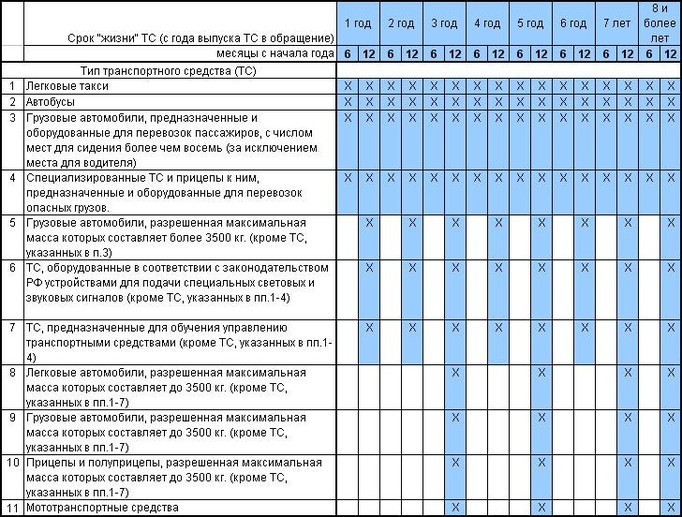
Technical inspection is a procedure necessary to determine the condition of the car and the possibility of its operation. After its completion, the owner receives a diagnostic card, on the basis of which he will be able to conclude an insurance contract.
Despite the applied nature of this procedure, you need to know what documents are needed to pass the technical inspection, because if they are absent, the card will not be issued.
Vehicle age
The timing and frequency of vehicle inspection are determined according to the category and age of the vehicle.
It has been established that vehicles less than three years old do not need diagnostics. Older cars should be inspected to ensure they are in good working order and that their systems comply with established requirements (for example, headlight adjustments).
Regardless of age and year of manufacture, every year it is necessary to diagnose:
- trucks heavier than 3.5 tons;
- training vehicles;
- transport equipped with special sound and lighting systems.
Certain categories of vehicles undergo technical inspection even more often - once every six months:
- Taxi;
- trucks equipped with seats for transporting passengers;
- buses;
- transport carrying dangerous goods.
Privately owned trailers do not need to be taken for diagnostics.
Validity periods
It has been established that the validity period of the technical inspection is limited. They are determined by the year of manufacture of the vehicle: older cars will have to be checked more often. If the car falls within the period from 3 to 7 years, then the document is valid for 2 years. A vehicle manufactured more than 7 years ago must be inspected every year.
New cars under 3 years old do not need diagnostics.
You should pay attention to the frequency of diagnostics, which depends on the year of manufacture of the vehicle.
If you purchase a used car for which a card has already been issued, you do not need to go through the diagnostics again. The document will be valid as long as it is supposed to, regardless of the change of owner.
Documentation
Despite the fact that a technical inspection involves checking a technical component, documents are required to document its results. There are not many of them, so it won’t be difficult to remember exactly what documents are needed to pass a vehicle inspection:
- owner's passport and driver's license;
- notarized power of attorney, if the card is not received by the owner;
- PTS and registration certificate.
Price issue
Carrying out diagnostics is a paid procedure. Its approximate cost is determined by the Federal Tariff Service and is approximately 960 rubles. In reality, this amount is slightly less (we are talking about the most common category of transport - “passenger cars”).
In different regions, the price of this service is different, since the entity has the right to determine the cost of this service at its own discretion. This issue falls within the competence of the constituent governments.
The price is directly dependent on the category of the vehicle. Traditionally, the most expensive are passenger and freight transport. The cheapest are motorcycles.
How is a technical inspection carried out?
To obtain a diagnostic card, you need to contact a maintenance operator. One of his employees will inspect the car, after which he will decide whether the car can be used. It is possible that during the inspection some comments will appear, then the document will not be issued until the car owner eliminates them.
During the inspection, the following systems and individual parts are checked:
- numbers, fire extinguisher, first aid kit and their compliance with established standards;
- brakes;
- light settings;
- suspension and steering play;
- windshield wiper;
- tires and wheels;
- exhaust toxicity;
- locks;
- technical fluids.
In addition, the procedure includes instrumental diagnostics of the car. And some vehicles will have their emergency call system checked (all categories of vehicles transporting people or dangerous goods).
Where is it held?
Once upon a time, a vehicle inspection ticket could only be obtained from the traffic police. He was then replaced by technical inspection operators. These include organizations or private businessmen who have received appropriate accreditation for vehicle diagnostics.
The dealer is also able to carry out the technical inspection. Thus, it is possible to purchase a diagnostic card during scheduled maintenance or outside of it, since diagnostics are not required for new cars.
Fine
Previously, traffic inspectors could ask to see a diagnostic card from bus or taxi drivers. Since 2017, ordinary motorists must also carry this document.
For a primary violation, the sanction is small, but for a repeated violation, the driver can lose his license and pay a large fine.
Knowing what documents are needed to carry out a vehicle inspection and its frequency, you can get rid of problems with obtaining an insurance policy and claims from traffic police officers, as well as keep your equipment in working condition. After all, a car inspection is required not so much by the insurance company as by the driver himself.
Source: https://AutoLawyer.guru/texosmotr/dokumenty-i-sroki-to/
Passing technical inspection of new and old cars
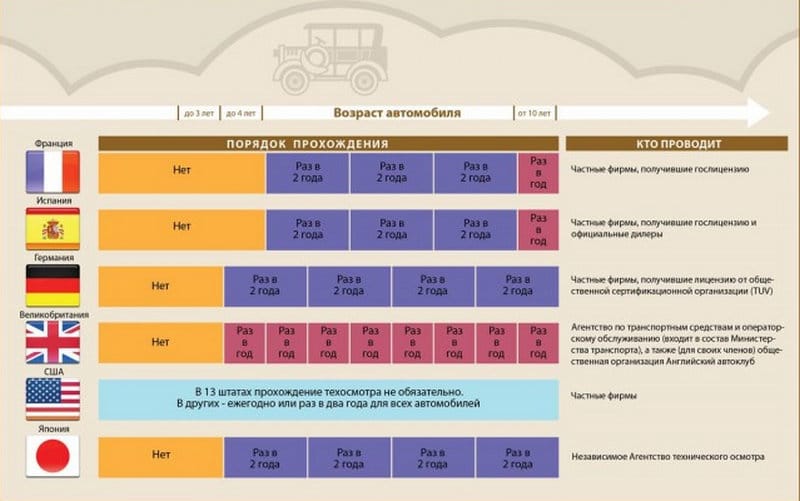
The main and main task of passing a technical inspection for all cars is to ensure safety on the roads.
To increase the level of safety and simplify bureaucratic unnecessary procedures during its passage, a TO reform was carried out in January 2012.
Based on it, the maintenance ticket was canceled, and a diagnostic card appeared, which must be provided for compulsory insurance.
Table of contents:
In order to pass a technical inspection without difficulty, you must prepare the car for inspection, submit all the necessary documents and adhere to the accepted rules. Below in the article we will try to describe all the nuances of technical inspection that every vehicle owner encounters. Namely, how and when to go through, what documents are needed, and what requirements are imposed on the vehicle during the inspection.
What is the deadline?
How to properly pass a technical inspection?
Everyone knows that it is necessary to undergo technical inspection regularly, but not all car owners know when and for what period. There are established rules for the frequency of maintenance, which are different for each type of vehicle, as well as the year of manufacture. The deadlines remained the same as before the 2012 reform.
So, each type of vehicle needs to undergo technical inspection at different times, depending on whether it is new or not.
Passenger cars, motorcycles and trucks weighing up to 3.5 tons:
- For 1-3 years – no passing required;
- From 3 to 7 years – passing is required once every two years;
- Over 7 years old – you need to go once a year.
Trucks weighing more than 3.5 tons, trailers and semi-trailers:
- Needs to be done once a year.
Buses and cargo-passenger vehicles with more than 8 seats (excluding the driver), as well as trucks with trailers that transport dangerous goods:
Jet skis and small craft:
Floating vessels with a mass of less than 200 kg and a power of less than 8 kW do not need to pass.
Tractors and self-propelled vehicles with a power greater than 50 cc (or 4 kW):
For seasonal equipment – within the first 15 days of the start of work.
Vehicles with special signals and beacons, as well as training:
Procedure for passing technical inspection
As we found out earlier, a new car does not need to undergo technical inspection during the first 3 years from the date of manufacture by the factory. After the 3-year period has expired, it will be necessary to carry out an inspection for the first time at a maintenance station. After the adopted changes came into effect, the order of its passage also changed.
The first thing you need to do is fill out an application to have your car checked at a service station, which can be done either on the website of the relevant company or made an appointment by phone. A service station can be either private or public, you can choose any one.
It is necessary to pay attention to the fact that it must be accredited and have the right to check cars and transfer information about checked cars to the EAISTO database. Next, you need to pay for the inspection procedure to the inspection operator, in other words, pay for the diagnostic card.
During the inspection, the organization's employees transmit information about each vehicle being inspected to the database (called EAISTO).
Upon completion of the technical inspection, each owner receives a diagnostic card with the test result. One copy remains at the service station and they send the electronic version of the card to the EAISTO database. There it will be stored for a long time, namely 5 years.
After the reform of the technical inspection procedure, the allotted time that was allocated for checking one vehicle unit also changed. If we remember what happened earlier, the technical inspection could take up to thirty days. Now fixed numbers have been established. Thus, to check cars with a gasoline engine it takes no more than 39 minutes, with a diesel engine – no more than 43 minutes.
With the received diagnostic card, you can already go to the insurance company for an MTPL policy. Here, insurance specialists are required to verify the information provided with a single database. If everything matches, then there will be no problems in obtaining the policy. If it turns out that the diagnostic card is not valid, the insurance agent refuses to insure the car.
In this case, it will be necessary to undergo a second technical inspection, for which a period of no more than 20 days is allotted. During repeated maintenance, only those vehicle components where comments were found should be checked. This maintenance is paid, and the cost is determined based on the amount of work that needs to be performed.
What documents are needed?
What documents are required for maintenance?
During the technical inspection, you are required to provide all documents established by the Russian government. This package of documents changed after the new technical inspection rules came into force, which came into force on January 1, 2012.
So, on the basis of the reform, the following documents were canceled:
- Medical certificate that the driver is required to obtain.
- OSAGO policy.
Now these documents that must be provided to the driver when passing the technical inspection include the following:
- Identity card - Russian passport for citizens or Russian military ID for military personnel;
- License – Driver's license;
- Vehicle registration certificate or vehicle passport (PTS);
Note. It is allowed to pass through inspection points instead of the owner by another person, but only with a power of attorney.
In addition to documents from the driver, you will also need the following information:
- Brand and size of installed tires (For example: Kama Euro-224, R14, 185/60);
- Current mileage readings.
The list of documents has been reduced and now for maintenance it is not necessary to undergo a medical examination to obtain a medical certificate. This is a big relief for all drivers, because...
To obtain it, as practice shows, you need to go through up to 10 doctors, stand in queues and spend at least a whole day of your time. A medical certificate will now only be required to obtain or exchange a driver's license.
As for the MTPL policy, the procedure has now been reversed: now, in order to obtain an insurance policy, you will need to undergo a technical inspection.
How to properly draw up a power of attorney (sample)?
It is possible to undergo technical inspection without the presence of the owner, but with a power of attorney from him.
A power of attorney for a technical inspection is drawn up in the usual handwritten form, similar to a power of attorney for the right to drive a vehicle, which was written before and was later canceled.
It must indicate the full name of the owner and his representative, residence address and registration, as well as vehicle details.
Download a sample form: Sample (form) of a power of attorney to undergo a technical inspection.
In order for this power of attorney to be executed correctly, it must indicate:
- “a power of attorney was issued for the right to undergo a technical inspection, as well as to perform all actions related to it.”
If the owner’s representative will also pay for the diagnostic card, then the power of attorney should additionally indicate the following:
- “with the right to pay in cash for technical inspection and other expenses.”
What are the requirements for the car?
In order for a vehicle to pass inspection the first time, it must meet certain requirements.
If any comments are found, you will have to undergo maintenance again, and this, as you know, is not a free service. Therefore, it is better to prepare the car in advance and pass the technical inspection the first time. Taking into account changes from 01.01.
2012 inspection should not exceed 45 minutes, depending on the gasoline or diesel engine.
Requirements for the car that are required for technical inspection:
- Appearance – the body of the vehicle must be clean and washed, otherwise it will not be allowed into the maintenance station stand.
- No tinted front windows or windshield.
- There should be no cracks in the windshield in the line of sight.
- Tires must be installed according to weather conditions. It is prohibited to install different tire treads on one axle, as well as combining studded tires with summer tires.
- Tire sizes and pressures must meet the operating requirements of the machine.
- Proper operation of low, high and side lights, repeaters and brake lights.
- The handbrake is working properly.
- The sound signal must be in working condition, the parameters must meet the requirements of vehicle operation.
- Availability of a first aid kit (GOST), a fire extinguisher and an emergency sign.
We recommend watching this video:
Source: http://AvtoPravilo.ru/chto-nuzhno-dlya-proxozhdeniya-texosmotra/


